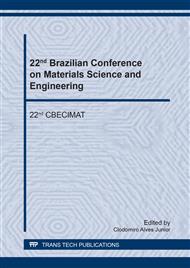p.317
p.322
p.327
p.333
p.339
p.345
p.349
p.356
p.362
Effects of Different Annealing Times on Microstructure and Tensile Properties of Joints Welded 5052 Aluminum Alloy in Marine Industry
Abstract:
The welding process is widely used for boat building, but the process for aluminum (base metal) is affected by the welding heat may affect the mechanical properties of the joint. The objective of this study was to evaluate the effect of different annealing times of welded joints of naval aluminum 5052 by MIG. The thermal annealing treatments were 30 and 60 min. at 300 °C. For the evaluation of the influence of different times of annealing on the properties were carried out tensile, hardness and their microstructures observed by optical microscopy. The heat treatment using 30 min. at 300 °C got higher mechanical property. The tensile test showed a higher value for the treatment 30 min. The microhardness showed a higher value for the weld pool of treatment 30 minu.. Microscopic analysis showed microstructural changes after annealing.
Info:
Periodical:
Pages:
339-344
Citation:
Online since:
September 2018
Keywords:
Price:
Сopyright:
© 2018 Trans Tech Publications Ltd. All Rights Reserved
Share:
Citation:


